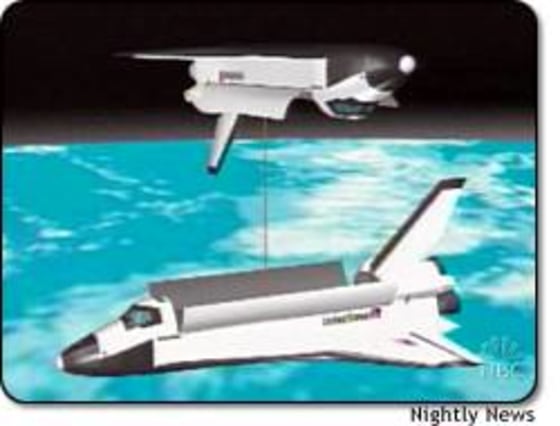A NASA study demanded by the independent board investigating the Columbia disaster has confirmed earlier assessments that technically there was a fighting chance to save the seven astronauts, if only management had been aware of their mortal danger in time. Although most commentators have focused on the Hollywood-style details of the theoretical rescue mission, the board’s chairman seemed much more interested in what the failure to exercise this option implied about NASA’s leadership.
Retired Navy Adm. Harold Gehman Jr., chairman of the Columbia Accident Investigation Board, referred to the issue in an offhand comment during his telephone briefing for space journalists on Friday. He pointed out that the findings had serious implications for NASA’s decision not to pursue military imaging of the potentially damaged left wing of the shuttle. Although several engineering teams had tried to get such images made during the flight, all such efforts were canceled before being carried out.
Far from looking like another “bureaucratic, fumbling-bumbling” error, Gehman commented, it elevated the NASA indecisiveness “to a much more serious life-and-death kind of decision process” that, in the end, failed to provide managers with the information they would have needed to order the rescue mission. Such decisions, Gehman declared, “look more ominous.”
Gehman said he had asked NASA a month ago to study possible repair or rescue options that might have been selected if the agency had found out about the lethal wound to Columbia’s wing almost immediately. The assumption was that the decision to proceed would have occurred within a few days of launch on Jan. 16, and that the knowledge needed to justify it had been obtained “by some miracle,” he admitted.
Under such conditions, life support supplies could well have been stretched to last about 30 days, if an immediate and severe slowdown of crew activities had been ordered. That in turn would have provided just barely enough time, “if all went well,” for the next-in-line shuttle, Atlantis, to launch on a rescue mission around Feb. 12.
The rescue mission was “rehearsed with different sets of astronauts, and they all said it could be done,” Gehman reported. “They were standing out in the hallways to volunteer.”
Gehman said the mission would be “very, very risky, but not impossible.” He added, “We’re way beyond our knowledge level here.”
Evidence was needed
The technical feasibility of this option must still be balanced against the decision-making process that needed enough evidence to initiate it. The military photographs, for example, wouldn’t have been available until halfway through the 16-day flight. They might well have shown damage to tiles just behind the left wing’s leading edge, since damaged tiles lose their black covering and show bright white. But this may have distracted from the far more dangerous and far less visible damage to panels on the leading edge, where a hole in a dark gray reinforced carbon-carbon shield would result in a darker hole behind a dark surface.
Only a visual inspection by a spacewalking astronaut, based perhaps on “suspicious” smudges seen in imagery, would have provided enough hard data to convince NASA mission managers that the shuttle was severely damaged. And such an inspection would probably not have been possible until well into the second half of the mission, when most of the supplies had already been used up. By that point, there wouldn’t have been enough time to get Atlantis ready for a safe launch.
The wing inspection was feasible, Gehman reported. The NASA study had “devised a successful way to get out to the area of damage, without further damaging the thermal protection system,” he explained.
NASA also studied the option of an in-flight repair of the damage, now believed to be a hole punched in one of the leading-edge reinforced panels. “Anything that had heat-absorbing properties” would be stuffed into the hole, Gehman reported, including flexible thermal blankets from the upper surface of the shuttle. Heavy metal objects such as stainless steel tools would be jammed into the breach, as well as bags of water that would be left to freeze. Teflon tape would cover the hole, and be cooled initially by the water ice behind it.
No studies have been made of the thermal properties of such a repair, he reported, but they will be. Whether it could have brought the Columbia all the way home, or merely low enough in the atmosphere for the crew to bail out safely, is unknown.
Resupply rockets?
Gehman’s commission to NASA did not include studying the option of launching an unmanned rocket carrying half a ton of life-extension supplies, which Columbia could have chased down and grabbed in orbit. Several expendable rockets were indeed nearing launch at various world space ports, and if any one of them could have been diverted to such an emergency resupply, major pressure to rush the next shuttle launch would have been relieved.
In response to a question, he said that scenario “was not in the bounds of the study,” but he promised to have it studied as well.
James Oberg, space analyst for NBC News, spent 22 years at the Johnson Space Center as a Mission Control operator and an orbital designer.
